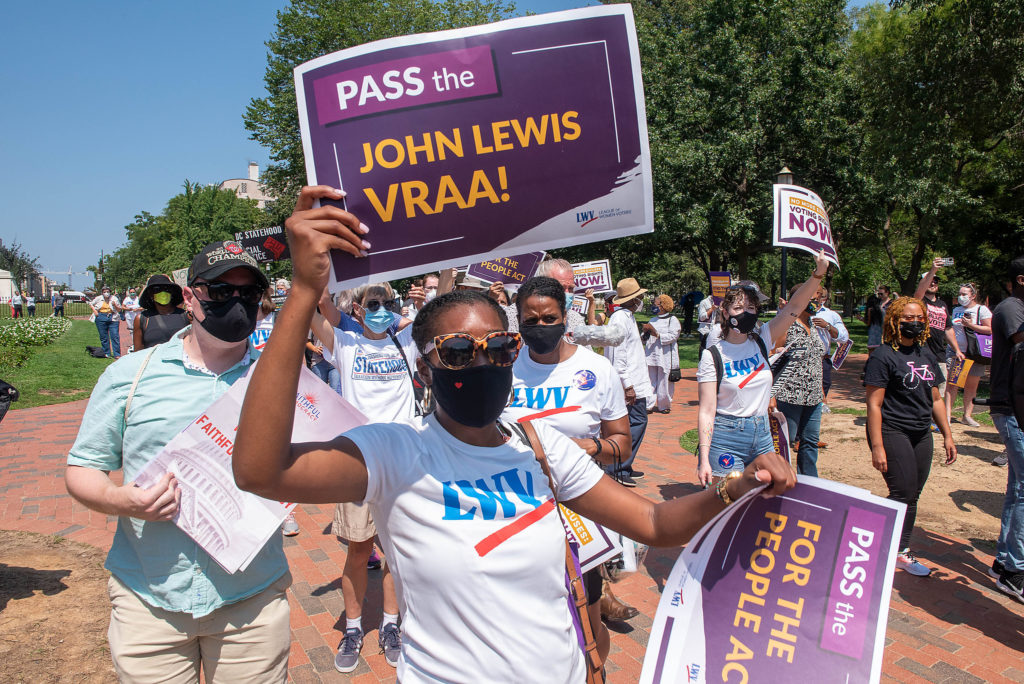The John R. Lewis Voting Rights Advancement Act (VRAA) amends the Voting Rights Act (VRA) of 1965 as needed to address the harm done by recent decisions of the U.S. Supreme Court (SCOTUS). See Background (below). The VRA of 1965 was designed to protect the right to vote, particularly in Southern States where voter suppression had been most egregious since the Reconstruction era.
This 2021 renewal of the VRA was named to honor Rep. John R. Lewis of Georgia, a civil rights icon who served 14 years in the U.S. House of Representatives until his death in 2020.
The VRAA establishes new criteria for determining which states and political subdivisions must obtain preclearance before changes to voting practices may take effect. Preclearance is the process of receiving preapproval from the U.S. Department of Justice (DOJ) or the U.S. District Court for the District of Columbia before making legal changes that would affect voting rights.
- Under the new criteria, a state and all of its political subdivisions shall be subject to preclearance of voting practice changes for a 10-year period if:
- 15 or more voting rights violations occurred in the state during the previous 25 years;
- 10 or more violations occurred during the previous 25 years, at least 1 of which was committed by the state itself; or
- 3 or more violations occurred during the previous 25 years and the state administers the elections.
- A political subdivision as a separate unit shall also be subject to preclearance for a 10-year period if three or more voting rights violations occurred there during the previous 25 years.
- States and political subdivisions that meet certain thresholds regarding minority groups must preclear covered practices before implementation, such as changes to methods of election and redistricting.
- Further, states and political subdivisions must notify the public of changes to voting practices.
- Next, the bill authorizes DOJ to require states or political subdivisions to provide certain documents or answers to questions for enforcing voting rights.
- The bill also outlines factors courts must consider when hearing challenges to voting practices, such as the extent of any history of official voting discrimination in the state or political subdivision.
Background
After the Civil War, the 15th Amendment was added to the Constitution so the right to vote could not be denied because of race, color, or previous condition of servitude (that is, slavery). Soon, States found ways to suppress the vote of black men in other “legal” ways, by using grandfather clauses, Jim Crow laws, literacy tests, and poll taxes, among others. Poll taxes were not outlawed by the 24th Amendment until 1964.
In 1920, the 19th Amendment was added to the Constitution so the right to vote could not be denied because of sex. However, it applied primarily to white women, because the practices used to suppress the vote of black men also suppressed the vote of black women.
As a practical matter, neither of these Amendments applied to persons of other races and ethnicities, including Native Americans and Asian Americans who lacked citizenship status.
Denial of the right to vote continued, especially for African-Americans, into the 1960s, more than 100 years after the Civil War.
In 1965, during a peaceful march in Selma, Alabama, John Lewis and his associates suffered severe and public beatings for being there and protesting for their right to vote. The brutality that day became nationwide news and one of the precipitating events of the civil rights movement that led to the passage of the Voting Rights Act later that year.
Finally, the VRA enabled the 15th Amendment to go to work. Congress extended the VRA in 1970, 1975, 1982, 2006 (Section 5). Nevertheless, state voter suppression laws began to flourish in the 21st century.
Then, in 2013 the Supreme Court of the United States (SCOTUS) in Shelby v. Holder struck down a key tool of the VRA, Section 4(b), which contained the coverage formula to determine which jurisdictions were subject to preclearance based on their histories of discrimination in voting. Ruling Section 4(b) to be unconstitutional (because it was based on data over 40 years old, making it no longer responsive to current needs), effectively undermined Section 5, which required states with a history of discrimination to get preclearance from the DOJ for any changes to their voting laws. Numerous states, most in the South, responded almost immediately to the SCOTUS decision with new voter suppression laws.
Since 2014, bills have been introduced in Congress to fix the damage done to the VRA. To date, none has passed.
Then, in 2021, SCOTUS (in Brnovich v DNC) began nibbling away at the remaining tool of the VRA. Section 2 of the VRA allows voters to seek relief if a state or local government has denied or limited their voting rights on the basis of their race, color, or membership in a language minority group. Unlike Section 5, it tends to be reactive, not preventative, and has primarily been used against voter ID rules, registration restrictions, early vote requirements, and redistricting legislation.
Justice Kagan, in her dissent, summarized Section 2: Courts are to strike down voting rules that contribute to a racial disparity in the opportunity to vote, taking all the relevant circumstances into account. In Brnovich, she concluded SCOTUS had failed in this mission.
ACTION NEEDED:
We urge all members of the League to contact Sen. Manchin and Sen. Capito to ask for their support for the John R. Lewis Voting Rights Advancement Act.
LWV-US and LWV-WV also urge everyone to press Sen. Manchin and Sen. Capito to take whatever actions are necessary in the Senate, including reform or elimination of the filibuster, to ensure that voting rights are secured.


